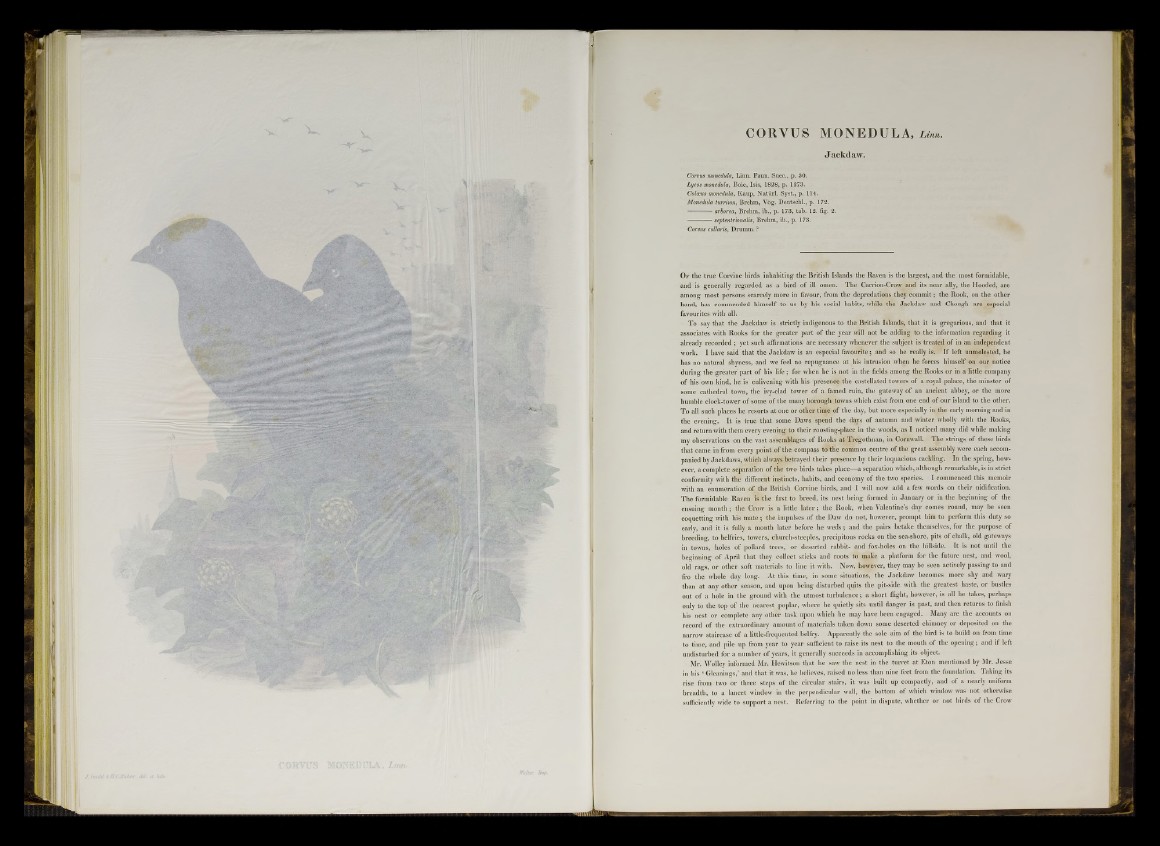
t v u s MOKEBBA,
J ackdaw.
Corvus monedula, Linn. Faun. Suec., p. 30.
Lycos monedula, Boie, Isis, 1828, p. 1273.
Colceus monedula, Kaup, Naturl. Syst., p. 114.
Monedula turrium, Brehm, Vog. Deutschl., p. 172.
---------- arborea, Brehm, ib., p. 173, tab. 12. fig. 2.
---------- septentrionalis, Brehm, ib., p. 173.
Corvus collaris, Drumm. ?
Of the true Corvine birds inhabiting the British Islands the Raven is the largest, and the most formidable,
and is generally regarded as a bird of ill omen. The Carrion-Crow and its near ally, the Hooded, are
among most persons scarcely more in favour, from the depredations they commit; the Rook, on the other
hand, has commended himself to us by his social habits, while the Jackdaw and Chough are especial
favourites with all.
To say that the Jackdaw is strictly indigenous to the British Islands, that it is gregarious, and that it
associates with Rooks for the greater part of the year will not be adding to the information regarding it
already recorded ; yet such affirmations are necessary whenever the subject is treated of in an independent
work. I have said that the Jackdaw is an especial favourite; and so he really is. ' If left unmolested, he
has no natural shyness, and we feel no repugnance at his intrusion when he forces himself on our notice
during the greater part of his life; for when he is not in the fields among the Rooks or in a little company
of his own kind, he is enlivening with his presence the castellated towers of a royal palace, the minster of
some cathedral town, the ivy-clad tower of a famed ruin, the gateway of an ancient abbey, or the more
humble clock-tower of some of the many borough towns which exist from one end of our island to the other.
To all such places he resorts at one or other time of the day, but more especially in the early morning and in
the evening. It is true that some Daws spend the days of autumn and winter wholly with the Rooks,
and return with them every evening, to their roosting-place in the woods, as I noticed many did while making
my observations on the vast assemblages of Rooks at Tregothnan, in Cornwall. The strings of these birds
that came in from every point of the compass to"the common centre of the great assembly were each accompanied
by Jackdaws, which always betrayed their presence by their loquacious cackling. In the spring, however,
a complete separation of the two birds takes place—a separation which, although remarkable, is in strict
conformity with the different instincts, habits, and economy of the two species. I commenced this memoir
with an enumeration of the British Corvine birds, and I will now add a few words on their nidification.
The formidable Raven is the first to breed, its nest being formed in January or in the beginning of the
ensuing month; the Crow is a little la te r; the Rook, wheu Valentine’s day comes round, may be seen
coquetting with his mate ; the impulses of the Daw do not, however, prompt him to perform this duty so
early, and it is fully a month later before he weds; and the pairs betake themselves, for the purpose of
breeding, to belfries, towers, church-steeples, precipitous rocks on the sea-shore, pits of chalk, old gateways
in towns, holes of pollard trees, or deserted rabbit- and fox-holes on the hillside. It is not until the
beginning of April that they collect sticks and roots to make a platform for the future nest, and wool,
old rags, or other soft materials to line it with. Now, however, they may be seen actively passing to and
fro the whole day long. At this time, in some situations, the Jackdaw becomes more shy and wary
than at any other season, and upon being disturbed quits the pit-side with the greatest haste, or bustles
out of a hole in the ground with the utmost turbulence; a short flight, however, is all he takes, perhaps
only to the top of the nearest poplar, where he quietly sits until danger is past, and then returns to finish
his nest or complete any other task upon which he may have been engaged. Many are the accounts on
record of the extraordinary amount of materials taken down some deserted chimney or deposited on the
narrow staircase of a little-frequented belfry. Apparently the sole aim of the bird is to build on from time
to time, and pile up from year to year sufficient to raise its nest to the mouth of the opening ; and if left
undisturbed for a number of years, it generally succeeds in accomplishing its object.
Mr. Wolley informed Mr. Hewitson that he saw the nest in the turret at Eton mentioned by Mr. Jesse
in his ‘ Gleanings,’ and that it was, he believes, raised no less than nine feet from the foundation. Taking its
rise from two or three steps of the circular stairs, it was built up compactly, and of a nearly uniform
breadth, to a lancet window in the perpendicular wall, the bottom of which window was not otherwise
sufficiently wide to support a nest. Referring to the point in dispute, whether or not birds of the Crow